Summer Outdoor Thermal Comfort in Urban Commercial Pedestrian Streets in Severe Cold Regions of China
Abstract
1. Introduction
2. Methods
2.1. The Site
2.2. Field Survey
2.2.1. Meteorological Parameter Measurements
2.2.2. Questionnaire Survey
2.3. UTCI
3. Results and Discussion
3.1. Results of the Meteorological Parameter Measurements
3.2. Results of Outdoor Thermal Sensation Survey
3.2.1. Basic Data
3.2.2. Outdoor Thermal Sensation and Thermal Comfort
3.2.3. Effects of Meteorological Parameters on Outdoor Thermal Sensation
3.2.4. Preference Vote of Meteorological Parameters
3.3. Outdoor Thermal Comfort Index
3.3.1. Correlation Analysis between MTSV and UTCI
3.3.2. Neutral UTCI and Neutral UTCI Range
3.3.3. Thermal Acceptability Range
3.3.4. Psychological Adaptation
4. Conclusions
- In summer, “Slightly warm” (TSV = 1) is the most common thermal sensation reported by residents in severe cold regions, and the outdoor thermal sensation is related to the different spatial scales. According to this study, the distribution of thermal sensation in severe cold regions in summer is tighter in areas of the outdoor environment with smaller SVF and less fluctuation, while the distribution is more dispersed in areas with larger SVF and greater fluctuation.
- This study shows that the effects of air temperature and solar radiation on outdoor thermal sensation is greater than that of wind speed in urban high-density commercial districts in severe cold regions in summer. Residents of severe cold regions are more sensitive to changes in air temperature and solar radiation in areas with a stable outdoor environment.
- It is confirmed that the UTCI can accurately evaluate outdoor thermal comfort levels in severe cold regions in summer. In comparison with Guangzhou, Hong Kong and Nagoya, the neutral UTCI in Harbin is lower and the range of neutral UTCI is wider, because residents in Harbin are more able to adapt to larger fluctuations in the outdoor environment.
- Residents of severe cold regions show psychological adaptations to the outdoor thermal environment in summer. The MTSV value in early summer is slightly higher by about 0.5 on the TSV scale to that in late summer.
- This work shows that the actual thermal acceptable range in summer in severe cold regions is 16.8–29.3 °C, which is wider than the predicted thermal acceptable range. In addition, in comparison with the neutral UTCI range, the actual thermal acceptable range takes into account the psychological adaptation of residents of severe cold regions to the outdoor environment, which is therefore of more practical reference value.
Author Contributions
Funding
Conflicts of Interest
References
- Cheung, C.S.C.; Hart, M.A. Climate change and thermal comfort in Hong Kong. Int. J. Biometeorol. 2014, 58, 137–148. [Google Scholar] [CrossRef]
- Hendel, M.; Azos-Diaz, K.; Tremeac, B. Behavioral adaptation to heat-related health risks in cities. Energy Build. 2017, 152, 823–829. [Google Scholar] [CrossRef]
- Patz, J.A.; Campbell-Lendrum, D.; Holloway, T.; Foley, J.A. Impact of regional climate change on human health. Nature 2005, 438, 310–317. [Google Scholar] [CrossRef] [PubMed]
- Lin, T.-P.; Dear, R.D.; Hwang, R.-L. Effect of thermal adaptation on seasonal outdoor thermal comfort. Int. J. Climatol. 2011, 31, 302–312. [Google Scholar] [CrossRef]
- Lai, D.Y.; Guo, D.H.; Hou, Y.F.; Lin, C.Y.; Chen, Q.Y. Studies of outdoor thermal comfort in northern China. Build. Environ. 2014, 77, 110–118. [Google Scholar] [CrossRef]
- Xu, M.; Hong, B.; Jiang, R.S.; An, L.; Zhang, T. Outdoor thermal comfort of shaded spaces in an urban park in the cold region of China. Build. Environ. 2019, 155, 408–420. [Google Scholar] [CrossRef]
- Ruiz, M.A.; Correa, E.N. Adaptive model for outdoor thermal comfort assessment in an Oasis city of arid climate. Build. Environ. 2015, 85, 40–51. [Google Scholar] [CrossRef]
- Nikolopoulou, M.; Lykoudis, S. Use of outdoor spaces and microclimate in a Mediterranean urban area. Build. Environ. 2007, 42, 3691–3707. [Google Scholar] [CrossRef]
- Mahmoud, A.H.A. Analysis of the microclimatic and human comfort conditions in an urban park in hot and arid regions. Build. Environ. 2011, 46, 2641–2656. [Google Scholar] [CrossRef]
- Shashua-Bar, L.; Hoffman, M.E. Vegetation as a climatic component in the design of an urban street: An empirical model for predicting the cooling effect of urban green areas with trees. Energy Build. 2000, 31, 221–235. [Google Scholar] [CrossRef]
- Oke, T.R. An algorithmic scheme to estimate hourly heat is land magnitude. In Proceedings of the 2nd Urban Environment Symposium, Albuquerque, NM, USA, 2–6 November 1998; pp. 80–83. [Google Scholar]
- Johansson, E. Influence of urban geometry on outdoor thermal comfort in a hot dry climate: A study in Fez, Morocco. Build. Environ. 2006, 41, 1326–1338. [Google Scholar] [CrossRef]
- Bourbia, F.; Boucheriba, F. Impact of street design on urban microclimate for semi arid climate (Constantine). Renew. Energy 2010, 35, 343–347. [Google Scholar]
- Qaid, A.; Ossen, D.R. Effect of asymmetrical street aspect ratios on microclimates in hot, humid regions. Int. J. Biometeorol. 2015, 59, 657–677. [Google Scholar] [CrossRef] [PubMed]
- Yin, S.; Lang, W.; Xiao, Y.Q. The synergistic effect of street canyons and neighbourhood layout design on pedestrian-level thermal comfort in hot-humid area of China. Sustain. Cities Soc. 2019, 49, 101571. [Google Scholar] [CrossRef]
- Jamei, E.; Rajagopalan, P.; Seyedmahmoudian, M.; Jamei, Y. Review on the impact of urban geometry and pedestrian level greening on outdoor thermal comfort. Renew. Sustain. Energy Rev. 2016, 54, 1002–1017. [Google Scholar] [CrossRef]
- De Freitas, C.R.; Grigorieva, E.A. A comparison and appraisal of a comprehensive range of human thermal climate indices. Int. J. Biometeorol. 2017, 61, 487–512. [Google Scholar] [CrossRef]
- Huang, J.X.; Zhou, C.B.; Zhou, Y.B.; Xu, L.Y.; Jiang, Y. Outdoor thermal environments and activities in open space: An experiment study in humid subtropical climates. Build. Environ. 2016, 103, 238–249. [Google Scholar] [CrossRef]
- Sajad, Z.; Naser, H.; Elahi, S.H.; Rasoul, H.; Keyvan, S.; Saeid, A. Comparing Universal Thermal Climate Index (UTCI) with selected thermal indices/environmental parameters during 12 months of the year. Weather Clim. Extrem. 2018, 19, 49–57. [Google Scholar]
- Xu, M.; Hong, B.; Mi, J.Y.; Yan, S.S. Outdoor thermal comfort in an urban park during winter in cold regions of China. Sustain. Cities Soc. 2018, 43, 208–220. [Google Scholar] [CrossRef]
- Chen, X.; Xue, P.N.; Gao, L.X.; Du, J.; Liu, J. Physiological and thermal response to real-life transient conditions during winter in severe cold area. Build. Environ. 2019, 157, 284–296. [Google Scholar] [CrossRef]
- Du, J.; Sun, C.; Xiao, Q.K.; Chen, X.; Liu, J. Field assessment of winter outdoor 3-D radiant environment and its impact on thermal comfort in a severely cold region. Sci. Total Environ. 2020, 709, 136175. [Google Scholar] [CrossRef] [PubMed]
- Kottek, M. World Map of the Koppen-Geiger climate classification updated. Meteorol. Z. 2006, 15, 259–263. [Google Scholar] [CrossRef]
- Watson, I.D.; Johnson, G.T. Graphical estimation of sky view-factors in urban environments. Int. J. Climatol. 1987, 7, 193–197. [Google Scholar] [CrossRef]
- Johnson, G.T.; Watson, I.D. The Determination of View-Factors in Urban Canyons. J. Appl. Meteorol. 1984, 23, 329–335. [Google Scholar] [CrossRef]
- Krüger, E.L.; Minella, F.O.; Rasia, F. Impact of urban geometry on outdoor thermal comfort and air quality from field measurements in Curitiba, Brazil. Build. Environ. 2011, 46, 621–634. [Google Scholar] [CrossRef]
- Lin, T.P.; Tsai, K.T.; Hwang, R.L.; Matzarakis, A. Quantification of the effect of thermal indices and sky view factor on park attendance. Landsc. Urban Plan. 2012, 107, 137–146. [Google Scholar] [CrossRef]
- Wei, R.H.; Song, D.X.; Wong, N.H.; Martin, M. Impact of Urban Morphology Parameters on Microclimate. Procedia Eng. 2016, 169, 142–149. [Google Scholar] [CrossRef]
- Lin, T.P.; Matzarakis, A.; Hwang, R.L. Shading effect on long-term outdoor thermal comfort. Build. Environ. 2010, 45, 213–221. [Google Scholar] [CrossRef]
- Matzarakis, A.; Rutz, F.; Mayer, H. Modelling radiation fluxes in simple and complex environments: Basics of the RayMan model. Int. J. Biometeorol. 2010, 54, 131–139. [Google Scholar] [CrossRef]
- Holst, J.; Mayer, H. Impacts of street design parameters on human-biometeorological variables. Meteorol. Z. 2011, 20, 541–552. [Google Scholar] [CrossRef]
- ISO International Standard 7726. Thermal Environment-Instruments and Method for Measuring Physical Quantities International Standard Organization; ISO: Geneva, Switzerland, 1998. [Google Scholar]
- Yao, J.W.; Yang, F.; Zhuang, Z.; Shao, Y.H.; Yuan, P.F. The effect of personal and microclimatic variables on outdoor thermal comfort: A field study in a cold season in Lujiazui CBD, Shanghai. Sustain. Cities Soc. 2018, 39, 181–188. [Google Scholar] [CrossRef]
- Xie, Y.X.; Huang, T.Y.; Li, J.N.; Niu, J.L.; Mak, C.M.; Lin, Z. Evaluation of a multi-nodal thermal regulation model for assessment of outdoor thermal comfort: Sensitivity to wind speed and solar radiation. Build. Environ. 2018, 132, 45–56. [Google Scholar] [CrossRef]
- Li, J.N.; Niu, J.L.; Mak, C.M.; Huang, T.Y.; Xie, Y.X. Assessment of outdoor thermal comfort in Hong Kong based on the individual desirability and acceptability of sun and wind conditions. Build. Environ. 2018, 145, 50–61. [Google Scholar] [CrossRef]
- Fiala, D.; Lomas, K.J.; Stohrer, M. Computer prediction of human thermoregulatory and temperature responses to a wide range of environmental conditions. Int. J. Biometeorol. 2001, 45, 143–159. [Google Scholar] [CrossRef] [PubMed]
- ANSI/ASHRAE. ASHRAE Handbook—Fundamentals; Chapter 24.3; ASHRAE: Atlanta, GA, USA, 2017. [Google Scholar]
- Huang, J.X.; Jose, G.C.; John, D.S. CityComfort+: A simulation-based method for predicting mean radiant temperature in dense urban areas. Build. Environ. 2014, 80, 84–95. [Google Scholar] [CrossRef]
- ISO International Standard 7730. Ergonomics of the Thermal Environment-Analytical Determination and Interpretation of Thermal Comfort Using Calculation of the PMV and PPD Indices and Local Thermal Comfort Criteria; ISO: Geneva, Switzerland, 2005. [Google Scholar]
- Chen, X.; Xue, P.N.; Liu, L.; Gao, L.X.; Liu, J. Outdoor thermal comfort and adaptation in severe cold area: A longitudinal survey in Harbin, China. Build. Environ. 2018, 143, 548–560. [Google Scholar] [CrossRef]
- Luo, M.H.; Richard De, D.; Ji, W.J.; Bin, C.; Lin, B.R.; Ouyang, Q.; Zhu, Y.X. The dynamics of thermal comfort expectations: The problem, challenge and implication. Build. Environ. 2016, 95, 322–329. [Google Scholar] [CrossRef]
- Luo, M.H.; Wang, Z.; Gail, B.; Bin, C.; Zhu, Y.X. Indoor climate experience, migration, and thermal comfort expectation in buildings. Build. Environ. 2018, 141, 262–272. [Google Scholar] [CrossRef]
- Fang, Z.S.; Xu, X.N.; Zhou, X.Q.; Deng, S.Q.; Wu, H.J.; Liu, J.L.; Lin, Z. Investigation into the thermal comfort of university students conducting outdoor training. Build. Environ. 2019, 149, 26–38. [Google Scholar] [CrossRef]
- Watanabe, S.; Nagano, K.; Ishii, J.; Horikoshi, T. Evaluation of outdoor thermal comfort in sunlight, building shade, and pergola shade during summer in a humid subtropical region. Build. Environ. 2014, 82, 556–565. [Google Scholar] [CrossRef]
- Yang, B.; Olofsson, T.; Nair, G.; Kabanshi, A. Outdoor thermal comfort under subarctic climate of north Sweden—A pilot study in Umeå. Sustain. Cities Soc. 2017, 28, 387–397. [Google Scholar] [CrossRef]
- Lin, T.P.; Tsai, K.T.; Liao, C.C.; Huang, Y.C. Effects of thermal comfort and adaptation on park attendance regarding different shading levels and activity types. Build. Environ. 2013, 59, 599–611. [Google Scholar] [CrossRef]

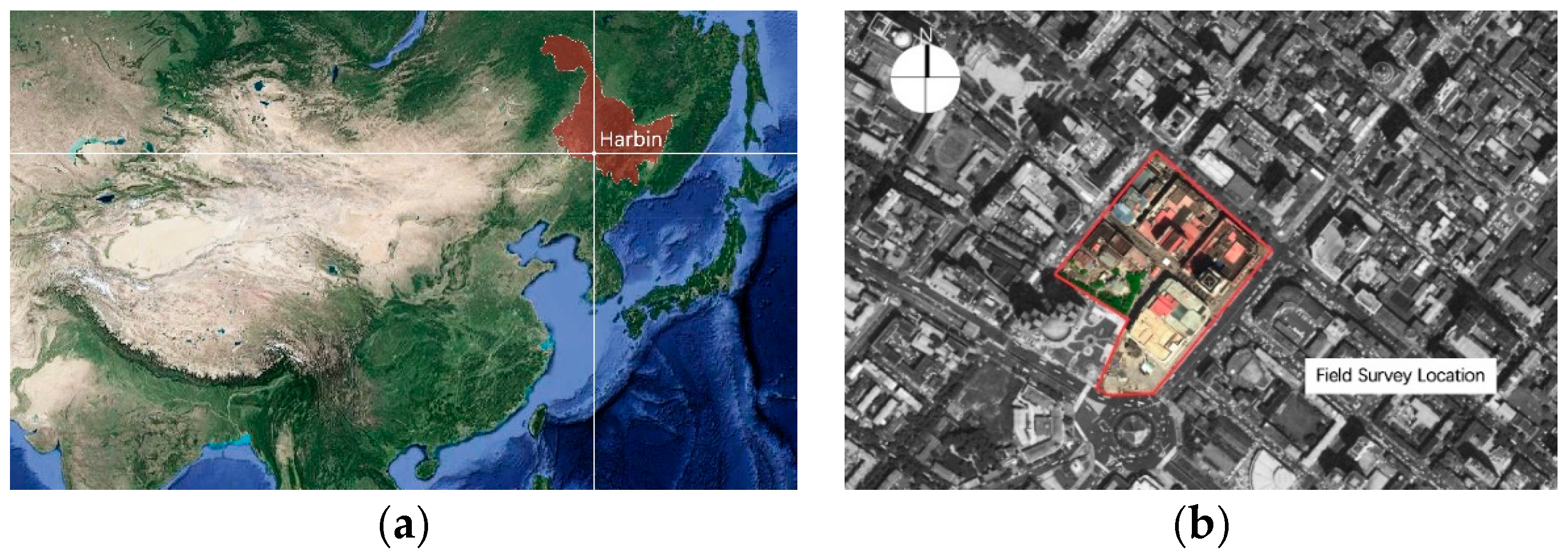


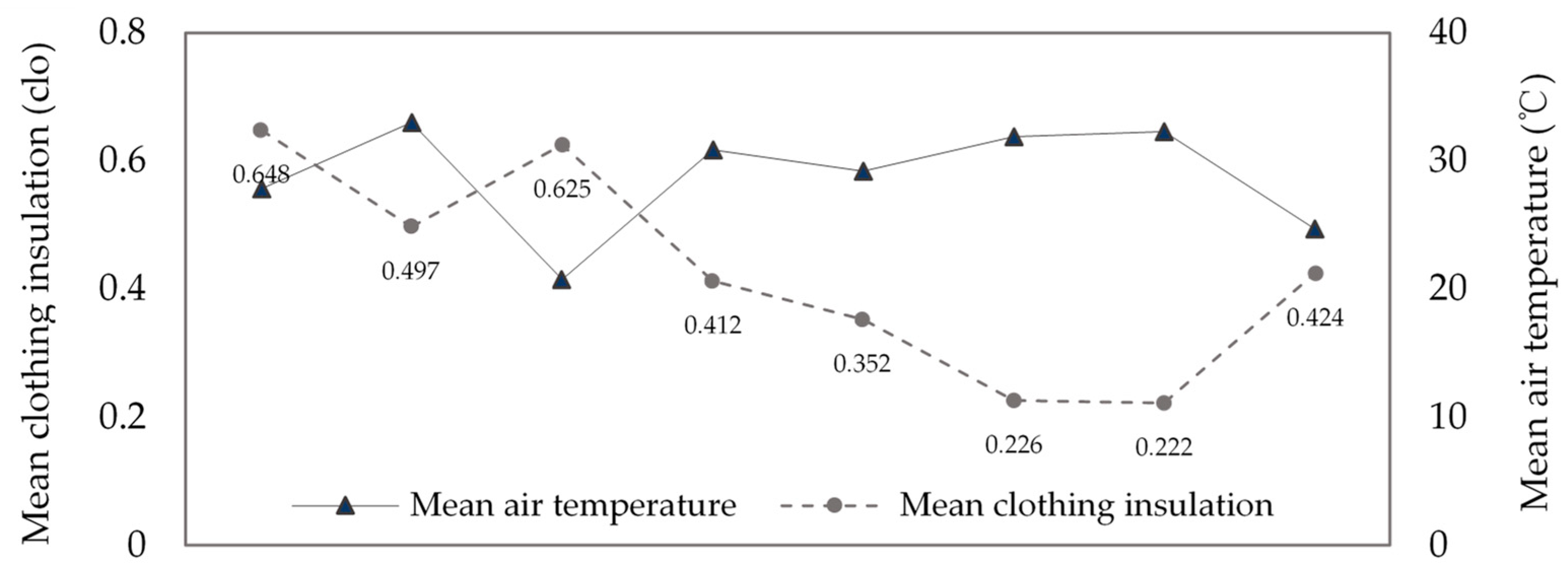
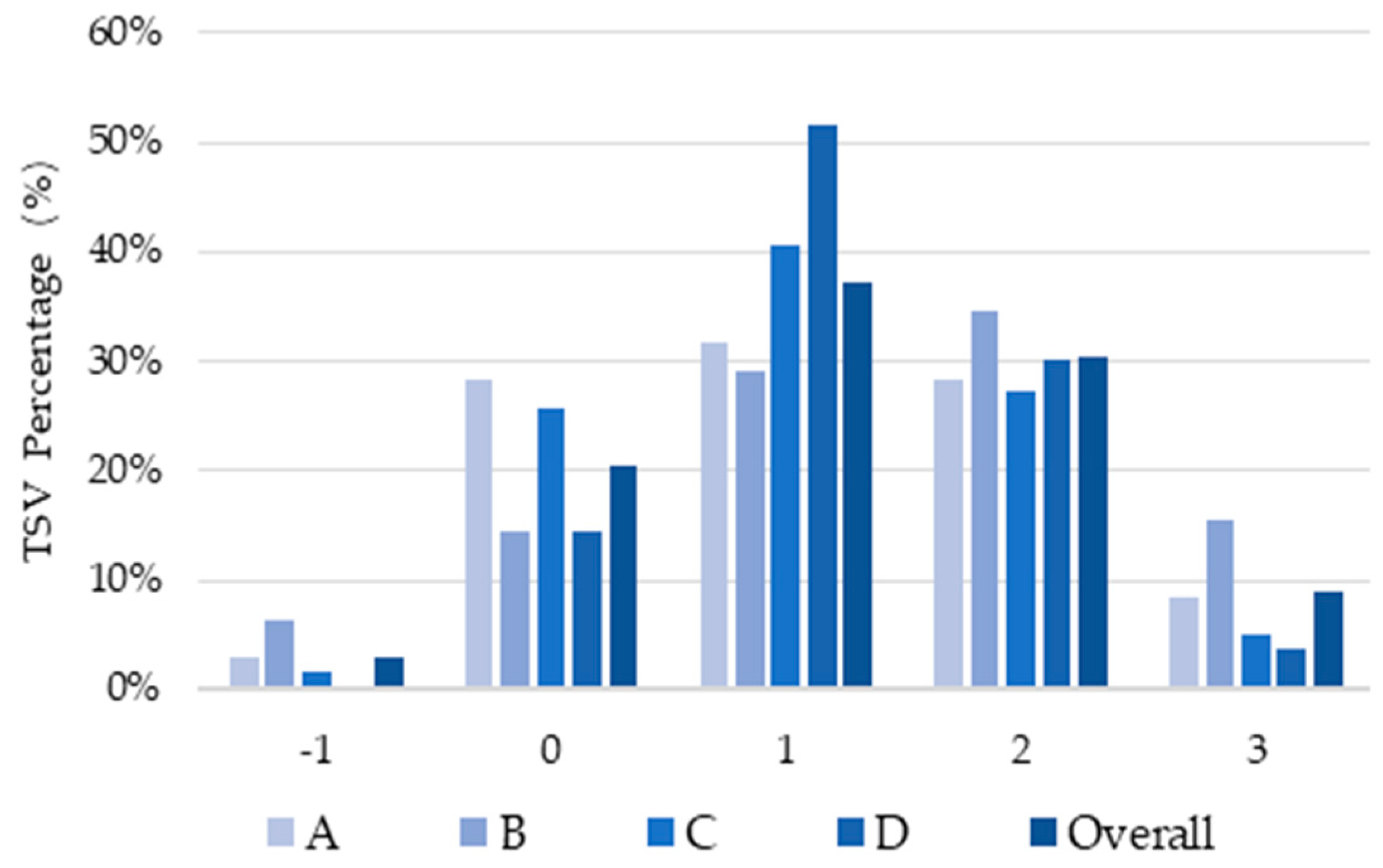
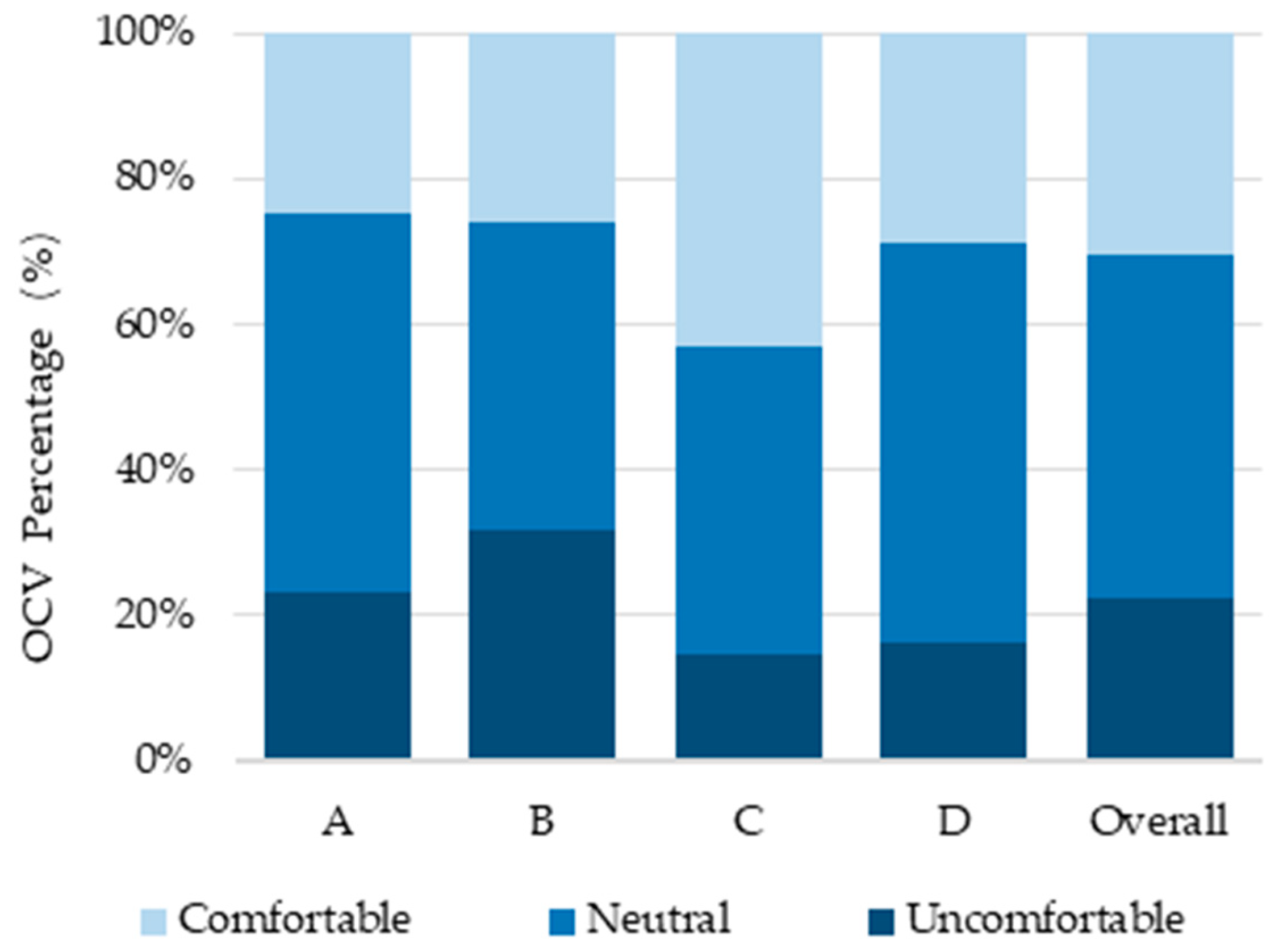

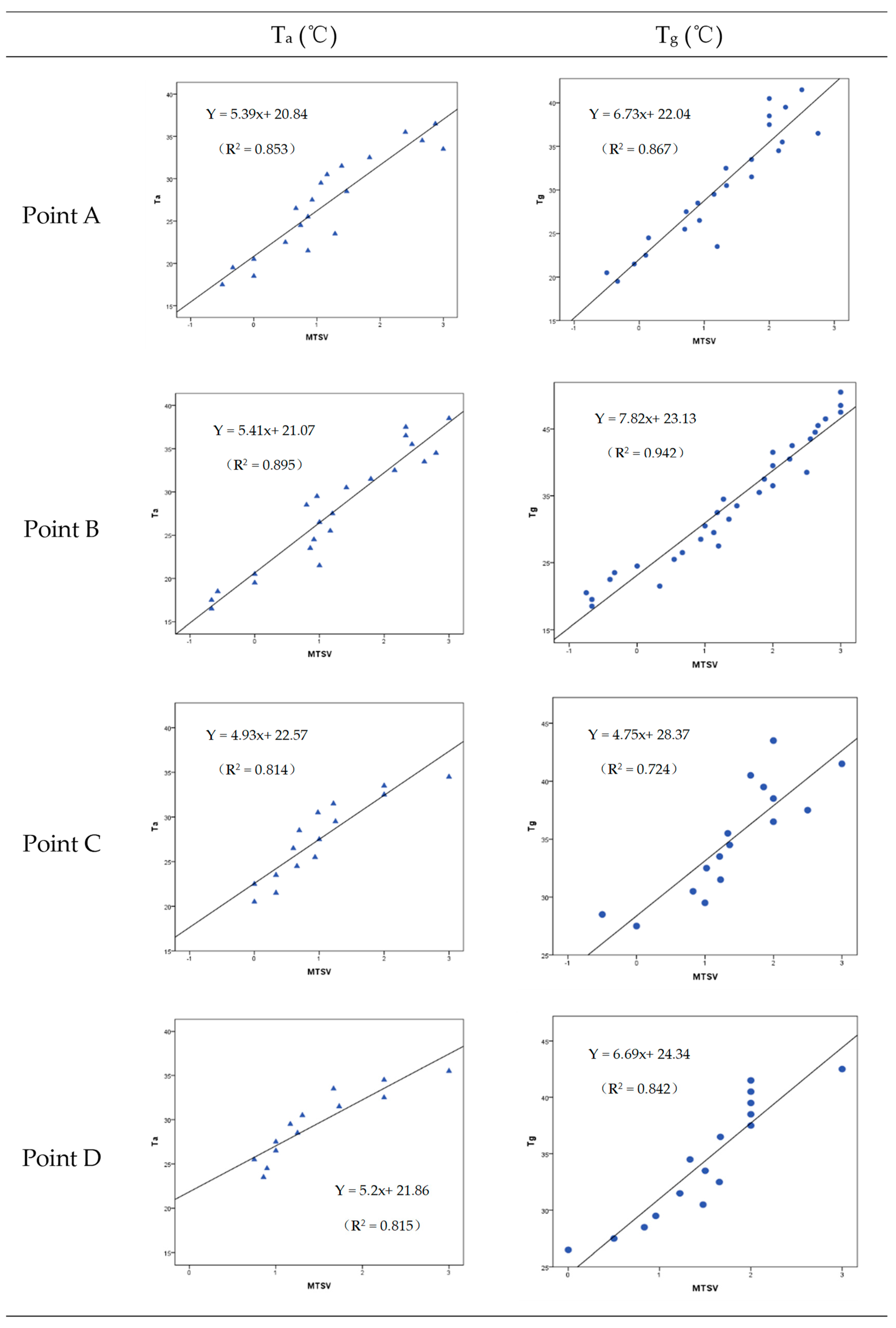



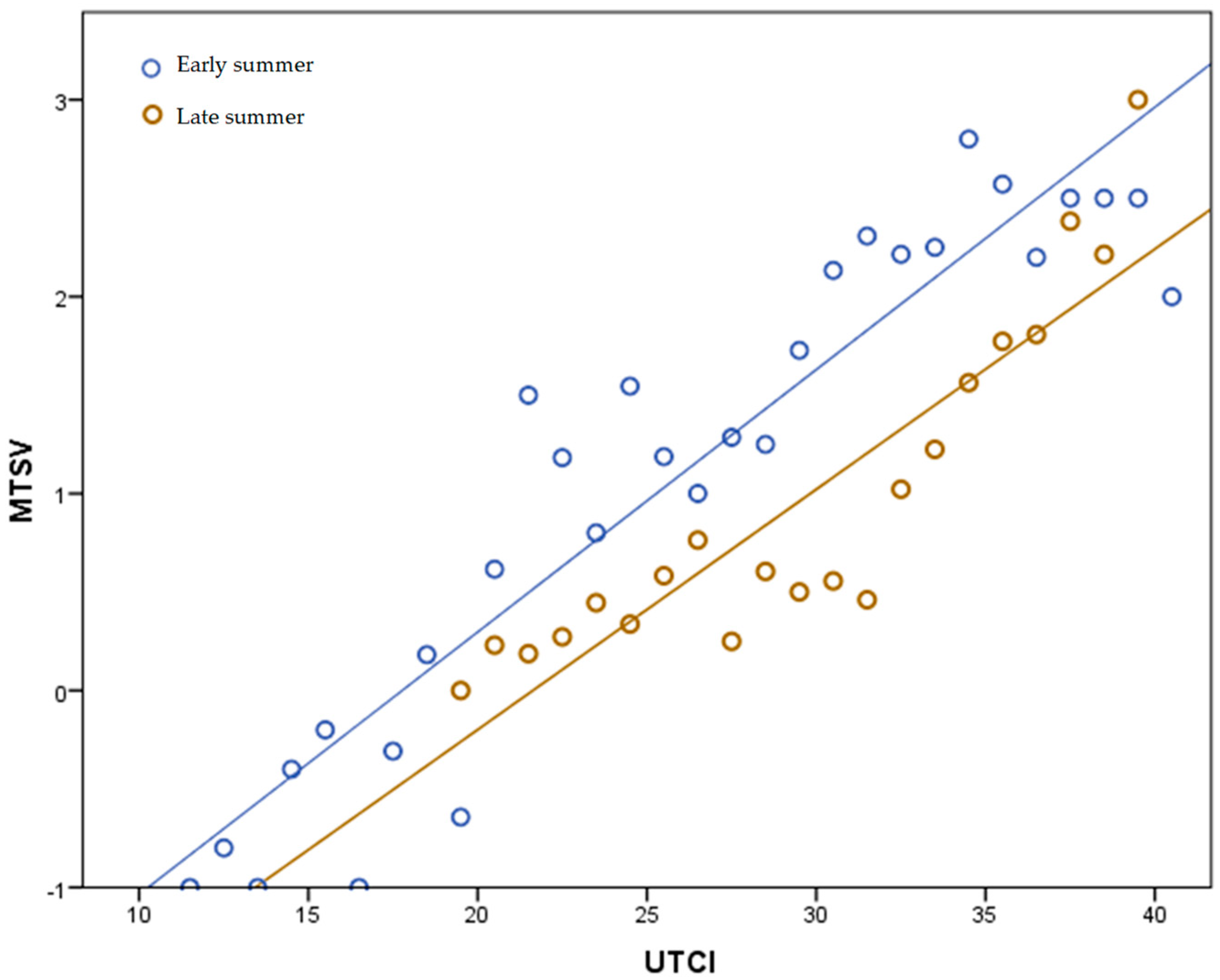
| Parameters | Symbol | Instrumentation | Range | Accuracy |
|---|---|---|---|---|
| Air temperature | Ta | Testo 480 | −20–70 °C | ±0.5 °C |
| Relative humidity | RH | Testo 480 | 0–100% (RH) | ±(1.0%RH + 0.7% measured value) (0–90% RH) ±(1.4%RH + 0.7% measured value) (90–100% RH) |
| Wind speed | Va | Kestrel N5500 | 0.4–40 m/s | ±0.1 m/s |
| Wind direction | - | Kestrel N5500 | 0–360° | 1° |
| Globe temperature | Tg | Testo 480 | 0–120 °C | ±0.1 °C |
| Questionnaire on Outdoor Thermal Comfort of Commercial Pedestrian Streets |
|---|
| Date:____ / ____ / ____ Time:________ Gender: (1) Male (2) Female Age:______ |
| 1. How long do you spend outdoors on average every day? |
| 0–30 min/30 min–1 h/1 h–2 h/More than 2 h |
| 2. The current position you are in: |
| Point A (Below the high-rise buildings) |
| Point B (Central point) |
| Point C (Intersection of Jianshe street and Youzheng street) |
| Point D (Youzheng street) |
| 3. Your current clothing includes (multiple choices): |
| Upper: □Vest □Underwear □Short sleeve T-shirt □Long sleeve T-shirt □Pullover □Shirt □Sweater □Jacket □Thick coat □Thin coat □Cotton clothes □Down jacket |
| Bottom: □Shorts □Short skirt □Trousers □Long skirt □Sweat pants □Woolen pant □Cotton pant |
| Footwear: □Sandals □Shoes □Boots □Cotton-padded shoes □Pantyhose □Ankle-length socks □Socks □low-cut liners socks |
| Others:___________________________ |
| 4. Your intensity in outdoor activities is: |
| (1) Light exercising (Tai Chi, look after children, brisk walking, etc.) |
| (2) Medium exercising (Jogging, etc.) |
| (3) Heavy exercising (High-intensity ball games, high-intensity ice sports, square dancing, etc.) |
| (4) Standing (Chatting, viewing, playing mobile phone, etc.) |
| (5) Sitting (Chatting, playing mobile phone, reading, playing chess, outdoor dining, etc.) |
| 5. Please describe your thermal sensation at present: |
| □−3 Cold □−2 Cool □−1 Slightly cool □0 Neutral □1 Slightly warm □2 Warm □3 Hot |
| 6. Please describe your overall comfort level at present: |
| □−1 Uncomfortable □0 Neutral □1 Comfortable |
| 7. Please describe your acceptable level for current thermal environment at present: |
| □−2 Extremely unacceptable □−1 Unacceptable □1 Acceptable □2 Extremely acceptable |
| 8. What changes do you expect from the following meteorological data at present: |
| Air temperature: □Higher □Unchanged □Lower |
| Relative humidity: □Higher □Unchanged □Lower |
| Wind speed: □Stronger □Unchanged □Weaker |
| Solar Radiation: □Stronger □Unchanged □Weaker |
| Ta (°C) | RH (%) | Tg (°C) | Va1.5m (m/s) | ||
|---|---|---|---|---|---|
| A | Average | 27.3 | 45.8 | 28.4 | 2.48 |
| Max | 35.1 | 66.6 | 41.0 | 15.01 | |
| Min | 17.1 | 26.2 | 19.4 | 0.08 | |
| B | Average | 31.8 | 36.9 | 36.5 | 1.91 |
| Max | 39.4 | 61.0 | 50.5 | 8.03 | |
| Min | 18.7 | 15.5 | 25.3 | 0.00 | |
| C | Average | 29.3 | 47.5 | 31.3 | 1.76 |
| Max | 35.0 | 66.0 | 43.8 | 9.19 | |
| Min | 23.9 | 25.5 | 24.1 | 0.05 | |
| D | Average | 28.9 | 47.9 | 29.7 | 0.56 |
| Max | 36.0 | 66.3 | 43.3 | 5.96 | |
| Min | 22.8 | 27.5 | 23.5 | 0.00 | |
| RH (%) | Ta (°C) | Tg (°C) | V1.5m (m/s) | |
|---|---|---|---|---|
| TSV | −0.319 ** | 0.577 ** | 0.560 ** | −0.129 ** |
| City, Country | Climatic Zone | Neutral UTCI (°C) | Neutral UTCI Range (°C) | Seasons | Calculation Methods |
|---|---|---|---|---|---|
| Habin, China (this study) | Dwa | 19.3 | 15.6–23.0 | Summer | MTSV and UTCI linear regression |
| Xi’an China [6] | Cwa/BSK | 23.1 | 18.5–29.6 | Summer/Winter | MTSV and UTCI linear regression & Probit regression |
| Tianjin, China [5] | Dwa/BSK | 17.5 | 13.6–21.3 | All year | MTSV and UTCI linear regression |
| Guangzhou, China [43] | Cfa | 26.0 | 24.0–28.1 | Summer | MTSV and UTCI linear regression |
| Hong Kong, China [35] | Cwa | 27.1 | 23.3–30.8 | Summer | MTSV and UTCI linear regression |
| Nagoya, Japan [44] | Cfa | 34.0 | 32.2–35.9 | Summer | MTSV and UTCI linear regression |
| Umeå, Sweden [45] | Dfc | 14.4 | 11.5–17.2 | Summer | MTSV and UTCI linear regression |
© 2020 by the authors. Licensee MDPI, Basel, Switzerland. This article is an open access article distributed under the terms and conditions of the Creative Commons Attribution (CC BY) license (http://creativecommons.org/licenses/by/4.0/).
Share and Cite
Zhu, Z.; Liang, J.; Sun, C.; Han, Y. Summer Outdoor Thermal Comfort in Urban Commercial Pedestrian Streets in Severe Cold Regions of China. Sustainability 2020, 12, 1876. https://doi.org/10.3390/su12051876
Zhu Z, Liang J, Sun C, Han Y. Summer Outdoor Thermal Comfort in Urban Commercial Pedestrian Streets in Severe Cold Regions of China. Sustainability. 2020; 12(5):1876. https://doi.org/10.3390/su12051876
Chicago/Turabian StyleZhu, Zheng, Jing Liang, Cheng Sun, and Yunsong Han. 2020. "Summer Outdoor Thermal Comfort in Urban Commercial Pedestrian Streets in Severe Cold Regions of China" Sustainability 12, no. 5: 1876. https://doi.org/10.3390/su12051876
APA StyleZhu, Z., Liang, J., Sun, C., & Han, Y. (2020). Summer Outdoor Thermal Comfort in Urban Commercial Pedestrian Streets in Severe Cold Regions of China. Sustainability, 12(5), 1876. https://doi.org/10.3390/su12051876




